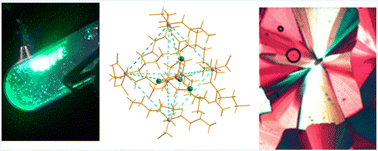Enhanced stability and complex phase behaviour of organic–inorganic green-emitting ionic manganese halides†
Abstract
Light-emitting materials based on earth-abundant metals, such as manganese hold great promise as emitters for organic lighting devices. In order to apply such emitter materials and, in particular, to overcome the problem of self-quenching due to cross-relaxation, we investigated a series of tetrabromidomanganate ([MnBr4]2−) salts with bulky tetraalkylphosphonium counter cations [Pnnn]+, namely [Pnnnn]2[MnBr4] (n = 4 (1), 6 (2) and 8 (3)), which can be obtained by a straightforward reaction of the respective phosphonium bromide and MnBr2. Variation of the cation size allows control of the properties of the resulting ionic materials. 1 and 3 qualify as ionic liquids (ILs), where 1 features a melting point of 68 °C, and 3 is liquid at room temperature and even at very low temperatures. Furthermore, 1 and 2 show the formation of higher-ordered thermotropic mesophases. For 1 a transition to a thermodynamically metastable smectic liquid crystalline phase can be observed at room temperature upon reheating from the metastable glassy state; 2 appears to form a plastic crystalline phase at ∼63 °C, which persists up to the melting point of 235 °C. The photoemission is greatly affected by phase behaviour and ion dynamics. A photoluminescence quantum yield of 61% could be achieved, by balancing the increase in Mn2+-Mn2+ separation and reducing self-quenching through increasingly large organic cations which leads to adverse increased vibrational quenching. Compared to analogous ammonium compounds, which have been promoted as @#x0308;inorganic hybrid perovskite![[s with combining umlaut]](https://www.rsc.org/images/entities/char_0073_0308.gif) , the phosphonium salts show superior performance, with respect to photoluminescent quantum yield and thermal and air/humidity stability. As the presented compounds are not sensitive to the atmosphere, in particular moisture, and show strong visible electroluminescence in the green region of light, they are important emitter materials for use in organic light-emitting devices.
, the phosphonium salts show superior performance, with respect to photoluminescent quantum yield and thermal and air/humidity stability. As the presented compounds are not sensitive to the atmosphere, in particular moisture, and show strong visible electroluminescence in the green region of light, they are important emitter materials for use in organic light-emitting devices.



 Please wait while we load your content...
Please wait while we load your content...